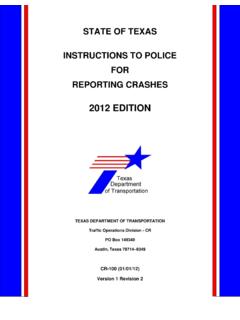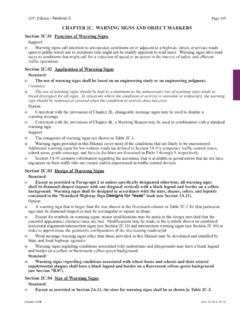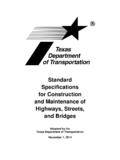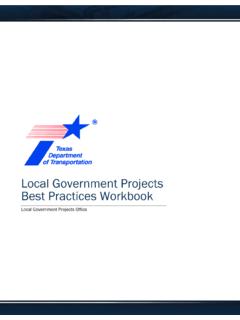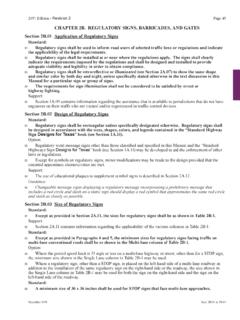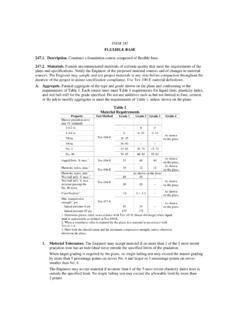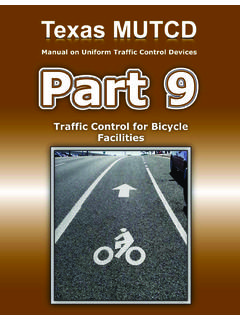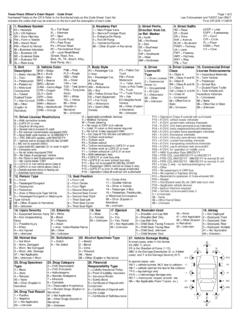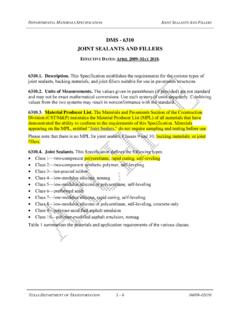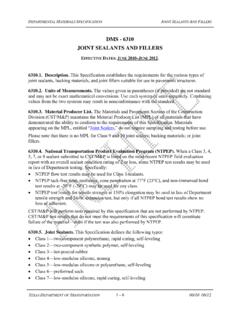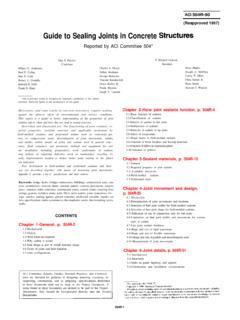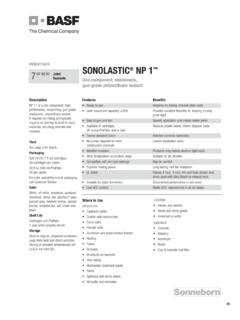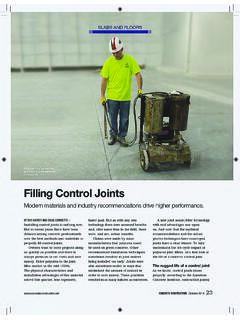Transcription of DMS-6310, Joint Sealants and Fillers
1 Departmental Material Specifications DMS-6310, Joint Sealants and Fillers DMS-6310, Joint Sealants and Fillers Overview Effective Date: August 2004 December 2006. This Specification establishes the requirements for the various types of Joint Sealants , backing materials, and Joint Fillers suitable for use in pavements structures. Units of Measurement The values given in parentheses (if provided) are not standard and may not be exact mathematical conversions. Use each system of units separately. Combining values from the two systems may result in nonconformance with the standard. Joint sealant Types This Specification defines the following types: Class 1 two-component synthetic polymer, non-sag Class 2 two-component synthetic polymer, self-leveling Class 3 hot-poured rubber Class 4 low-modulus silicone, non-sag Class 5 low-modulus silicone or polyurethane, self-leveling Class 6 preformed seals Class 7 low-modulus silicone, rapid curing, self-leveling Class 8 low-modulus silicone or polyurethane, self-leveling, concrete only Class 9 polymer-modified asphalt emulsion and Class 10 polymer-modified asphalt emulsion, non-sag.
2 Texas Department of Transportation 1 8/04 12/06. Departmental Material Specifications DMS-6310, Joint Sealants and Fillers Applicability The following table summarizes the materials and application requirements of the various classes. Joint sealant Applicability Features Classes 1 2 3 4 5 6 7 8 9 10. Material Synthetic Silicone or Silicone or Asphalt Asphalt Silicone Solid Silicone Polymer Polyurethane Polyurethane Emulsion 1- or 2- 21 21 1 1 1 1 21 1 1 1. component Self-Leveling NS SL N/A NS SL N/A SL SL SL NS. or Non-Sag Primer No No No No No No Yes No No No Required Backer Rod No No No Yes Yes3 No Yes Yes3 No No Required Joint Type2 ACS ACS AC ACS AC CS CS C AC AC. 1. These materials must cure by chemical reaction and not by evaporation of solvent or fluxing of harder particles.
3 2. Joint Types: A = asphalt-to-concrete; C = concrete-to-concrete; S = steel or armored. Other Joint types may be used provided the supplied sealant is evaluated for the proposed application. 3. Unless otherwise shown on the plans. Liquid and Semisolid Types Except for Class 6, each of the classes listed above consists of a 1- or 2-component liquid or semisolid compound that is poured into the Joint and solidifies after application. Properties Classes 1 and 2 must cure sufficiently to not pick up under the wheels of traffic after a maximum of 24 hr. at an average temperature of 25 1 C (77 2 F) unless another time is specified. (Three hours is commonly used.). Class 3 consists of a rubber-modified asphalt compound which, when heated to the manufacturer's recommended temperature, will melt to an appropriate consistency for pouring and then solidify when cooled to ambient temperatures.
4 Texas Department of Transportation 2 8/04 12/06. Departmental Material Specifications DMS-6310, Joint Sealants and Fillers Classes 1, 2, and 3 must meet the requirements of the following table. Synthetic and Bituminous Properties Material Class 1 Class 2 Class 3. Property Test Method Min Max Min Max Min Max Water content, % by mass Tex-501-C - 5 - 5 - - Cone Penetration, 150 g, 5 sec., 25 C (77 F), 48 hr. - 130 - 130 - 90. cure4. Flow at 25 C (77 F), 10 min., mm - 0 - - - - Flow at 60 C (140 F), 5 hr., mm ASTM D 5329 - - - - - 3. Flow at 70 C (158 F), 5 hr., 24 hr. cure, mm - 0 - 0 - - 4. Resilience, 48 hr. cure , % 50 - 50 - 60 - Resilience, oven aged, 5 hr. at 70 C (158 F), % 50 - 50 - - - Bond test, mm ( in.) wide, 50% extension, 3.
5 ASTM D 53292,3 pass1 pass1 pass1. cycles at -29 C (-20 F), 48 hr. cure4. 1. No evidence of cracking, separation, or other opening that is over 3 mm (1/8 in.) deep at any point in the sealer or between the sealer and the test blocks. 2. If joints other than asphalt or concrete are being sealed, use test blocks of the specified material 3. Exception to ASTM D 5329: For Classes 1 and 2, use spacer blocks to form a specimen mm long by mm wide by mm deep (2 in. long by in. wide by in. deep) as described in ASTM C 719, Section 4. For Class 3, use 12-hr. cure time. Texas Department of Transportation 3 8/04 12/06. Departmental Material Specifications DMS-6310, Joint Sealants and Fillers Classes 4 and 7 must be silicone compounds. Classes 5 and 8 may be of either silicone or polyurethane.
6 Classes 4, 5, 7, and 8 must meet the following requirements. Silicone and Polyurethane Properties Material Class 4 Class 5 Class 7 Class 8. Property Test Method Min Max Min Max Min Max Min Max Flow at room temperature, mm Tex-525-C - 5 - - - - - - Extrusion Rate, g/min ASTM C 11832 90 250 - - - - - - Tack-free time, minutes ASTM C 6791 35 75 - 120 30 60 - 120. Nonvolatile content, % Tex-525-C - - 93 - 93 - 93 - Tensile strength and 24-hr. extension test: Tex-525-C - - - - - - - - Initial cure time, days - 3 6 2 6. Strength after air curing only, psi - 10 50 3 10 4 30 4 30. Strength after water immersion, - 10 50 3 10 4 30 4 30. psi Strength after oven aging, psi - 10 50 3 10 4 30 4 30. Strength after bond test, psi - 10 50 3 10 4 30 4 30.
7 24-hr. extension test, all - pass pass pass pass specimens 1. Exception to ASTM C 679: Use a g (1 oz) weight and place it on the polyethylene strip for only 5 1 sec. 2. Exception to ASTM C 1183: Use 620 35 kPa (90 5 psi) pressure for the air supply. Classes 9 and 10 must be single component, polymer-modified emulsions composed primarily of a semisolid asphalt base, water, and an emulsifying agent; and must meet the requirements of the following table. Emulsion Properties Material Class 9 Class 10. Property Test Method Min Max Min Max Apparent viscosity, 25 C (77 F), Pa*s ASTM D 2196, 30 70 150 300. Method A. Vertical slump, 25 C (77 F), mm ASTM C 639 - - - 3. Residue by evaporation, % Tex-543-C 65 - 65 - Tests on Residue from Evaporation: Penetration, 25 C (77 F), 100 g, 5 sec.
8 AASHTO T 49 35 75 35 75. Softening Point, C AASHTO T 53 160 - 175 - Bond test, mm ( in.) wide, 50%. ASTM D 53292 pass1 pass1. extension, 3 cycles at C (0 F). 1. No evidence of cracking, separation, or other opening that is over 3-mm ( ) deep at any point in the sealer or between the sealer and the test blocks 2. If joints other than asphalt or concrete are being sealed, use test blocks of the specified material. Texas Department of Transportation 4 8/04 12/06. Departmental Material Specifications DMS-6310, Joint Sealants and Fillers Acceptance Accept Classes 1, 2, 3, 4, 5, 7, and 8 according to "Tex-538-C, Quality Monitoring for Joint Sealers and Related Materials." The list of materials that are currently prequalified under this procedure can be found at Prequalified Joint Sealers.
9 Accept Classes 9 and 10 according to "Tex-500-C, Sampling Bituminous Materials, Pre- molded Joint Fillers , and Joint Sealers.". Preformed Seals A Class 6 seal consists of a preformed extruded elastomeric material having a multi- channeled shape. This type must be installed with the aid of a lubricant adhesive. The size shown on the plans is the nominal width. Properties If the nominal width is smaller than 41 mm ( in.), the material must conform to the requirements of ASTM D 2628, except that the oil swell must be a maximum of 60%. If the nominal width is 41 mm ( in.) or greater, the material must conform to the requirements of ASTM D 3542, with the following exceptions: The oil swell must be a maximum of 60%;. The uncompressed depth must be greater than or equal to the width Determine compression-deflection properties using "Tex-613-J, Testing Preformed Joint Seals," rather than ASTM D 575.
10 The limits on the lateral pressure must be a minimum of 21 kPa (3 psi) at 15% compression and a maximum of 690 kPa (100 psi) at 50% compression, and the specimen must maintain complete contact with the loading plates throughout the test. Lubricant adhesive must: conform to the requirements of ASTM D 4070. be compatible with concrete and be unaffected by the normal moisture in the concrete. Acceptance Accept Class 6 with nominal widths of less than 41 mm ( in.) and all lubricant adhesive based on manufacturers' certification, according to the requirements of their respective specifications. Accept Class 6 with nominal widths of 41 mm ( in.) or more according to the following procedure: Texas Department of Transportation 5 8/04 12/06. Departmental Material Specifications DMS-6310, Joint Sealants and Fillers Prequalification: For each size and configuration proposed for use, submit a sample of at least 2 m (6 ft.)

